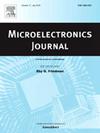An 89-dB SNDR 50-kHz BW CT ZOOM ADC employing FIR DAC to enhance the ADC linearity
IF 1.9
3区 工程技术
Q3 ENGINEERING, ELECTRICAL & ELECTRONIC
引用次数: 0
Abstract
This paper presents a CT Zoom ADC using a single-bit quantized first-order Sigma-Delta ADC as the coarse quantization ADC. The coarse quantization output is converted to be a multi-level output through a FIR filter, enhancing the ADC linearity and suppressing the sensitivity to clock jitter. Thus, not only can the designing difficulty be relieved, the power efficiency can be also improved. The fine-grained ADC adopts a third-order Sigma Delta ADC with single-bit quantization. The final output of the ZOOM ADC is the weighted average sum of the two-stage outputs.
In a 0.18 μm CMOS process, the circuit has achieved good performance. Within a bandwidth of 50 kHz, it achieves 89.3 dB SNDR, 14.5bits ENOB. The ADC core consumes 380 μW at a 1.8-V supply, resulting in a SNDR-based FoM of 170.5 dB. The size of the core ADC is 380μm × 520 μm.
求助全文
约1分钟内获得全文
求助全文
来源期刊

Microelectronics Journal
工程技术-工程:电子与电气
CiteScore
4.00
自引率
27.30%
发文量
222
审稿时长
43 days
期刊介绍:
Published since 1969, the Microelectronics Journal is an international forum for the dissemination of research and applications of microelectronic systems, circuits, and emerging technologies. Papers published in the Microelectronics Journal have undergone peer review to ensure originality, relevance, and timeliness. The journal thus provides a worldwide, regular, and comprehensive update on microelectronic circuits and systems.
The Microelectronics Journal invites papers describing significant research and applications in all of the areas listed below. Comprehensive review/survey papers covering recent developments will also be considered. The Microelectronics Journal covers circuits and systems. This topic includes but is not limited to: Analog, digital, mixed, and RF circuits and related design methodologies; Logic, architectural, and system level synthesis; Testing, design for testability, built-in self-test; Area, power, and thermal analysis and design; Mixed-domain simulation and design; Embedded systems; Non-von Neumann computing and related technologies and circuits; Design and test of high complexity systems integration; SoC, NoC, SIP, and NIP design and test; 3-D integration design and analysis; Emerging device technologies and circuits, such as FinFETs, SETs, spintronics, SFQ, MTJ, etc.
Application aspects such as signal and image processing including circuits for cryptography, sensors, and actuators including sensor networks, reliability and quality issues, and economic models are also welcome.
 求助内容:
求助内容: 应助结果提醒方式:
应助结果提醒方式:


